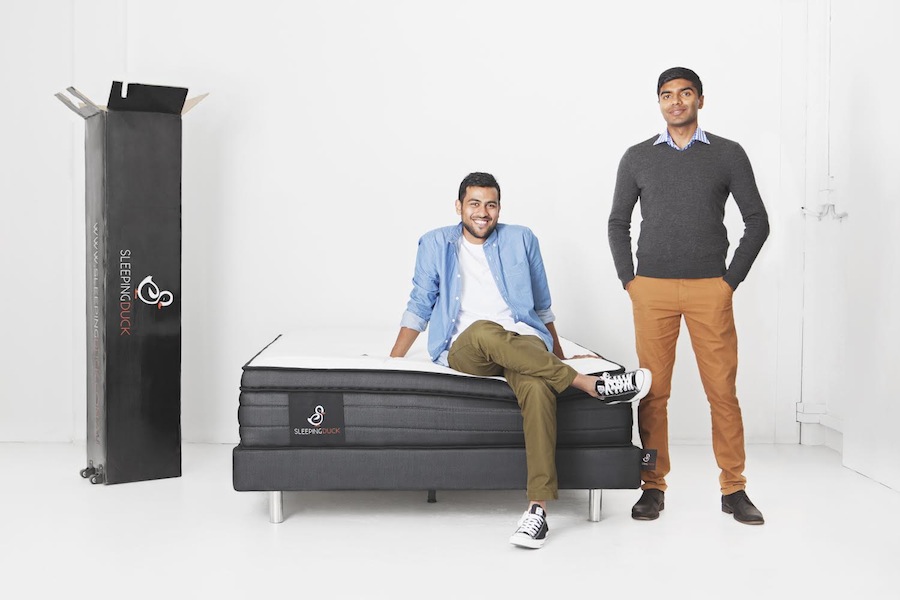Australia is a sleep-deprived nation, according to a NewsPoll survey commissioned by IKEA. The National Slumber Survey revealed that only one in 10 Australians felt rested and relaxed. The remainder of us are all too familiar with sleepless nights of tossing and turning, aching muscles and exhausted mornings. But what many of us overlook is the critical role a mattress plays in the quality of our sleep. The right mattress can help alleviate these problems, yet 72 percent of Australians are sleeping on uncomfortable beds.
Perhaps this is because mattress shopping isn’t a pleasant experience. You spend about a third of your life asleep, yet you’re pressured to choose a mattress based on a 15-minute in-store trial. Over time, the inherent weaknesses of the chosen mattress become apparent, and our bodies end up paying the price night after night. This is the dilemma Melbourne-based aerospace engineer Winston Wijeyeratne faced when purchasing his first ever mattress.
“A few months after starting work, buying a mattress was high on my list. It was going to be the first time I bought a brand new mattress in my life. The experience couldn’t have been worse. I tried three or four different stores, and consistently from the second I walked into the store I was being pressured,” says Wijeyeratne.
“They had no logical reason for the enormous price differences in the mattresses, they barely knew what was inside the mattress and worst of all they expected me to make a decision after lying on the mattress for 15 minutes!
“Everyone we spoke to had a similar initial story and an even worse sales experience.”
This inspired the inception of Sleeping Duck, a new online mattress startup founded by Wijeyeratne and civil engineer Selvam Sinnappan.
The duo met in ANZ’s graduate programme following the completion of engineering degrees at Monash University and University of Melbourne. They shared a frustration of the inefficiencies of big business.
“We noticed that working in a large business presented a number of difficulties, especially from a customer service perspective. We set out to develop a business that was simple enough to ensure the customer had the best possible experience,” says Wijeyeratne.
Choosing to break into the mattress industry was an easy one, according to Wijeyeratne, given his recent experience. Sinnappan says that the bricks and mortar mattress industry was in “desperate need of innovation”, particular in the area of customer service, given people were spending thousands of dollars on mattresses, only to be faced with disappointment.
Building the ‘perfect’ mattress and business model
Wijeyeratne and Sinnappan claim that Sleeping Duck has generated more than $1 million in revenue since January 2014 by selling 1,000 mattress via sleepingduck.com.au. This is an outstanding number for any startup – almost too good to be true.
But upon assessing Sleeping Duck’s product, business model and website UX, at least from a certain distance, it becomes clear why the startup has experienced success this early in the game.
The co-founders have purposefully changed the way people buy mattresses. One of the biggest problems we’re afflicted with in the First World is having too much choice. If you walk into Harvey Norman or any other department store, and enter the bedding section, you’ll see multiple rows of beds. You may briefly lie on a few mattresses that meet your budget (knowing that you can’t test it for too long, because the store doesn’t like it) and then give up, not really knowing the difference and not being able to make a truly informed decision.
With Sleeping Duck, instead of offering a large range of similar products, Wijeyeratne and Sinnappan decided to engineer what they claim to be is “one seriously comfortable mattress”. Wijeyeratne says that they analysed technology in the industry that had both positive and negative feedback, and then implemented what they concluded was the best.
Sleeping Duck’s mattress is made from a combination of pocket springs, gel-infused memory foam and natural latex. Wijeyeratne says that this is “completely different from any other mattress on the market”.
“We designed it to be modular. If a customer decides they are unhappy with the firmness we can simply send out new parts (free of charge) that will optimise their sleep experience,” he adds.
The price of the mattress starts at $799 for King Single and goes up to $1299 for a King-sized mattress. Bases can also be purchased at an extra cost – from $249 to $349. Wijeyeratne estimates an equivalent mattress would be three to four times this cost when purchased from a bricks and mortar retailer.
Sleeping Duck continually seeks to improve the product, calling as many customers as possible to gauge feedback from their experience. The co-founders then research, design, test and implement improvements based on the feedback. Wijeyeratne says that they will never release a version 2 of the product – rather, it will continue to improve over time.
The startup also offers a ‘60 Night Trial’. As Sinnappan explains, instead of trialling a mattress for 15 minutes in a store, Sleeping Duck allows customers to genuinely test out the mattress for 60 nights. If there are ways to improve the mattress, for instance by adjusting firmness, customers can request that free of charge. And if they’re still unhappy, they can return it free of charge and receive a full refund
“It’s essentially a no-pressure, no-risk service that people really appreciate,” says Sinnappan.
Another aspect of their customer service, that the co-founders feel have contributed to their growth is “efficient communication”. Wijeyeratne explains that if a customer has an issue, they answer the customer faster than they would a potential new buyer. This also makes sense from a strategic point of view, as an unhappy customer can return the product within the 60 night trial period and the business essentially loses a sale.
“The customer is our focus and we want each customer to feel like they are of the utmost importance to us,” says Wijeyeratne.
Sleeping Duck also calls customers upon delivery to check everything is well and follow up with a call after 40 days to ensure they’re happy with the product or whether any changes need to be made.
“This attentive and personalised experience has helped us grow to where we are today,” says Wijeyeratne.
The startup sells its product online, which may appear to be limiting as the sceptical customer has no way of seeing or touching the product prior to investing in it. However, Bigcommerce has predicted B2C ecommerce revenues to reach USD$2 trillion next year, which indicates that consumers are becoming increasingly accustomed to purchasing online, with search engines oftentimes being their primary mode of discovery when investigating products. The 60 night trial aspect of Sleeping Duck also offers peace of mind to those who aren’t as comfortable making a thousand-dollar investment online.
Added to that, the design of sleepingduck.com.au is sleek and minimalist; and the entire purchasing experience is simple. You choose the size of the mattress you want purchase, select from two modes of firmness (soft-medium and medium-firm) and indicate whether you want to add a base. Sleeping Duck immediately generates a price and takes you to the checkout where you fill out your delivery address and payment details.
“We are always endeavouring to improve our website so that customers can get a real feel for what the product will be like in their home,” says Wijeyeratne.
That said, Sleeping Duck is open to the prospect of establishing a physical presence, but feels that it has to be “done in the right way to improve the customer experience.”
Sleeping Duck’s first priority at the moment, from a business perspective, is to become a mainstream Australian brand. Wijeyeratne is cognisant of the fact that they’re competing with established players, but if the past 11 months indicates anything, it would be that Sleeping Duck has a real shot at dominating the mattress industry.
“If our product is always improving and our customers are genuinely happy then there is no reason our business shouldn’t keep growing,” says Wijeyeratne.
In fact, word-of-mouth referrals has been their biggest contributor to growth.
“Our major focus has been on ensuring that all our customers are getting a seriously restful night’s rest. Happy customers have led to a significant amount of referrals; we really wouldn’t be where we are without that,” says Wijeyeratne.
Sleeping Duck is also entertaining the idea of diversifying its product range to include accessories that help with sleep.
So what lies ahead for Sleeping Duck? The future of a startup is always uncertain, but this question could perhaps be best answered by why Wijeyeratne and Sinnappan named their startup Sleeping Duck in the first place,
“Ducks are an interesting animal. They sleep with one eye open. For us it’s our commitment to always be on the lookout for what’s coming and new ways to do things,” says Wijeyeratne.




















Trending
Daily startup news and insights, delivered to your inbox.